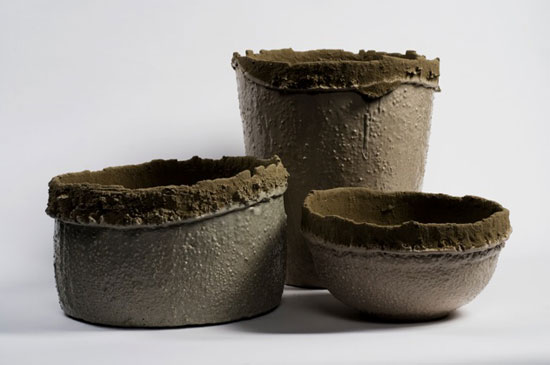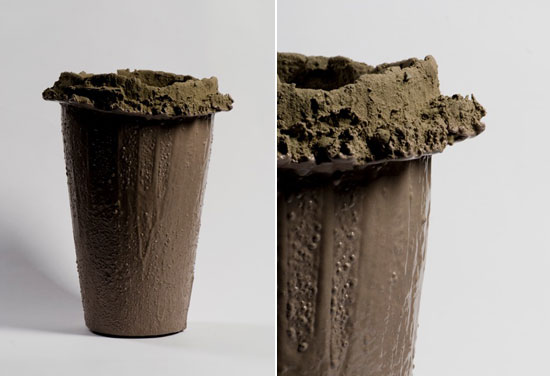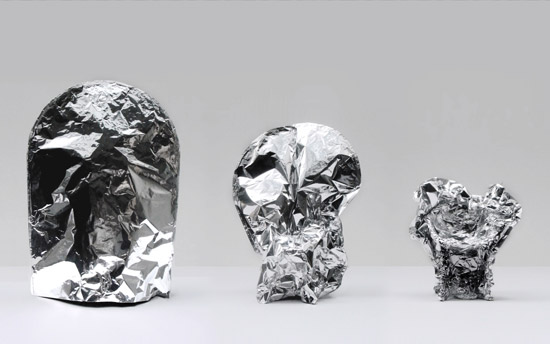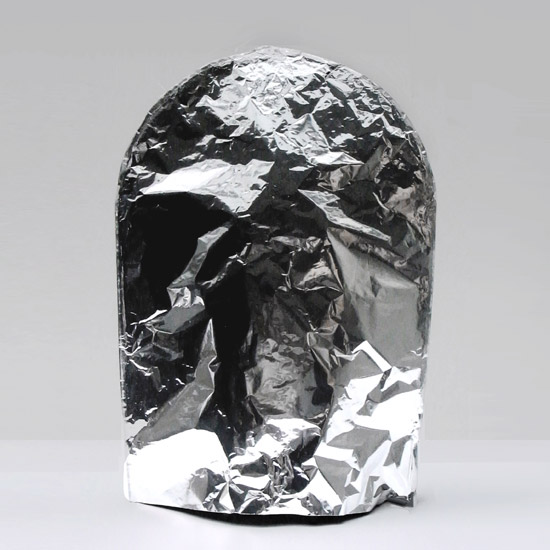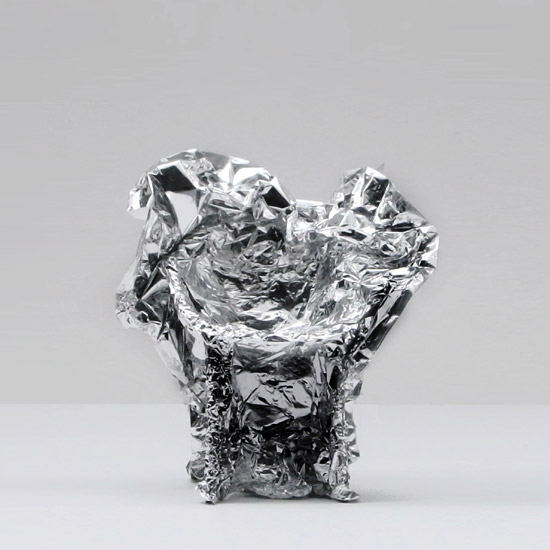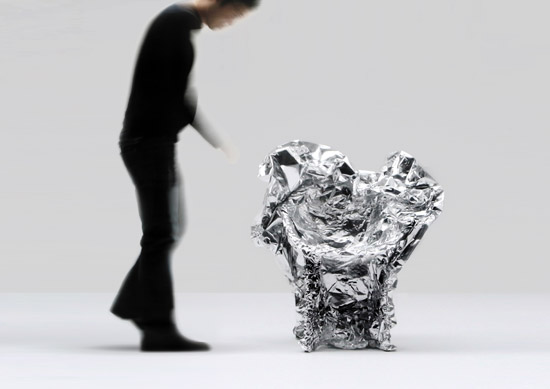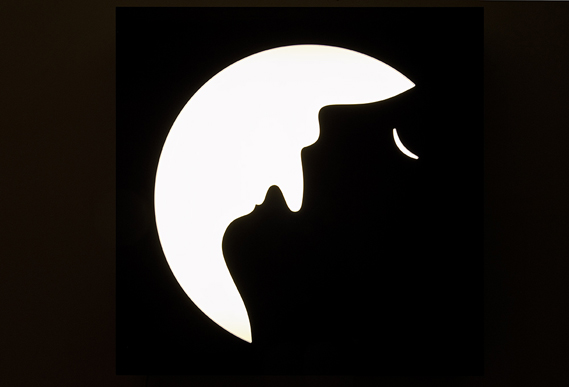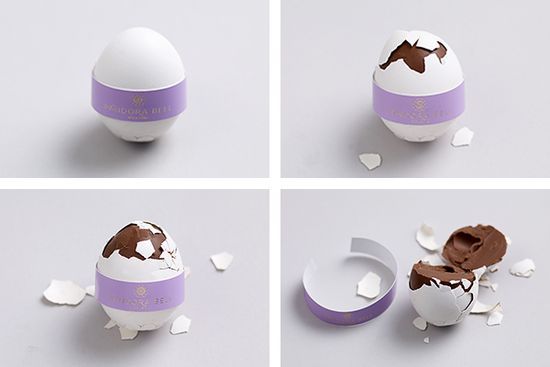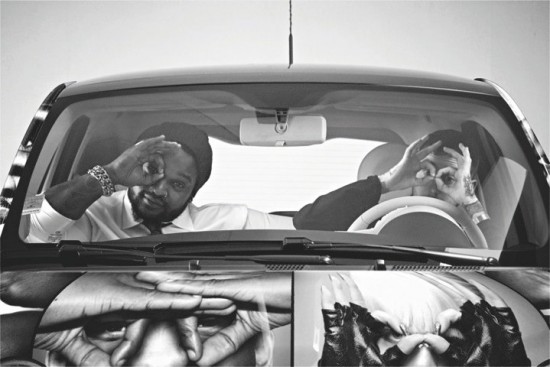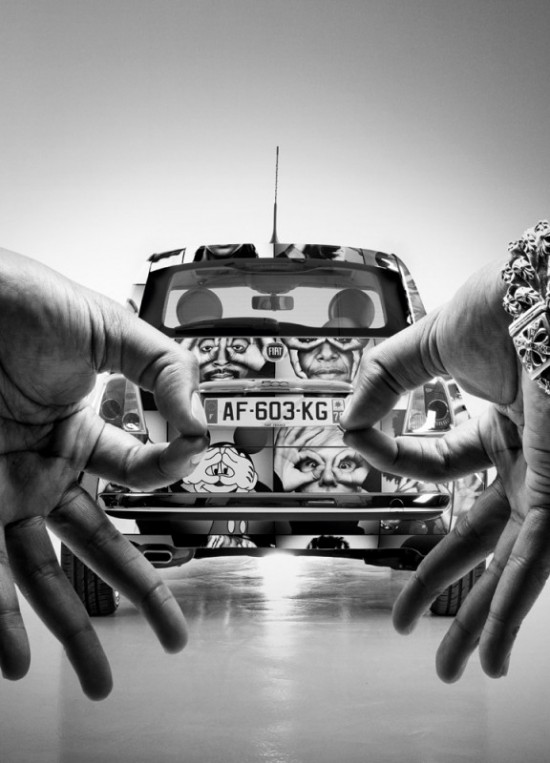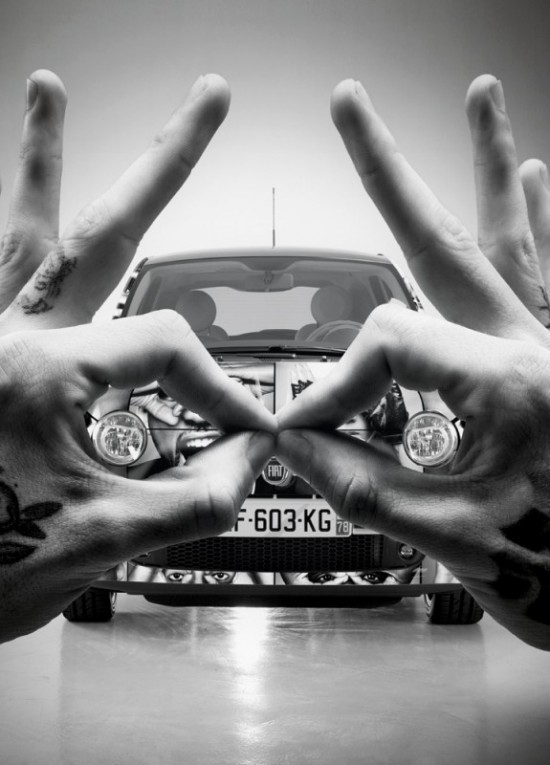


Luzinterruptus' latest light installation - a criticism of the lack of green spaces in modern cities. Leaves are trapped in plastic containers.
Wednesday, March 31
Luzinterruptus, Packaged Vertical Garden, Madrid
studio sjoerd jonkers: neolastic vases
'neolastic' vases by studio sjoerd jonkersdutch design studio sjoerd jonkers will present 'neolastic' vases at tuttobene during
milan design week 2010. for the exhibition jonkers created a collection of ten objects,
showing a broad view of colors, shapes and sizes of handmade plastic casted in a
sand mold.'neolastic' is based on the principles of experimental archeology. each object is
handmade with plastics casted in sand molds. the objects presented focus on
simplicity and confront our views of modern civilization.
neolastic vase - 30cm diameter, 25 cm height
neolastic vases - 40 cm diameter, 30 cm height
detail
neolastic vase - 60cm diameter, 60 cm height
'neolastic' vase - 35 cm diameter, 70 cm height
tokujin yoshioka: 'memory' for moroso
japanese designer tokujin yoshioka has designed 'memory' chair for italian company moroso,
which will be presented during milan design week 2010.
'memory' chair sequence'memory' is a chair of unlimited forms. its design is completed through the alteration
of its silhouette. for the project, yoshioka developed a special fabric made with recycled aluminum,
which he has used to create a chair that transforms and memorizes its shape upon use.'this chair might remind us of the beauty in nature with its ever-changing expression,
and also create impressions as if there is no presence of design.' - TY
'memory' chair in its beginning state
transformation occurring...
'memory' chair
tokujin yoshioka with the 'memory' chair
Creative Review - Noma Bar at KK Outlet
Bitter Sweet, a new exhibition of illustrator Noma Bar's work, opens tonight at KK Outlet in London's Hoxton Square...
Fans of Bar's work will recognise some of the imagery exhibited in the show – which runs until April 30 – from his most recently published book, Negative Space, published by Mark Batty Publisher last year – although, specially for this show, Bar has transformed flat illustrations into a variety of objects that include 3D wood cuts, installation pieces, screenprints and light boxes, all available to buy.
KK Outlet has very kindly sent us some photos of some of the work in the show (which was hung yesterday) to preview here on the CR blog...
More Or Less
Blind Optimism
Night Train to London
Epic Fail
Think Harder
Now You See Them Now You Don'tBitter Sweet runs until 30 April at KK Outlet, 42 Hoxton Square, London, N1 6PB.
See more of Bar's work at dutchuncle.co.uk
The Chocolate Artisans – POPSOP.COM. Brand news. Brand design. Package design. Branding agencies. Brand experts
Until fairly recently, many ‘armchair entrepreneurs’ – despite the success of their inventions – were regarded with a touch of humour and humility…Until, that is, Innocent, Dyson and Method to name just a few gained the creative and commercial recognition for their brand innovations.
Today, there is a new, growing and truly sparkling generation of entrepreneurial brands that – brand and consumer alike – we emulate and aspire to and which have taken hold of and are shaping the markets in a way never seen before. These brands are anything but armchair bound. They are challengers. They have a clear purpose to bring about change and – with design being the living embodiment of change – understand that this is where the opportunity lies to challenge existing norms and conventions to create a new brand design landscape for a new age.
These challengers are defined by their simplicity, originality and expression of a new idea but recently we have been starting to see yet another incarnation of the entrepreneurial and challenger brands with a re-focus on – or re-surgence of – the artisanal.
Green & Blacks was the original artisan chocolate brand that has become the leading iconic and luxury chocolate brand and there are very many snapping at its heels…so with Easter just around the corner – and a mass of ‘samey’ eggs appearing on shelves – I thought I would look at some of the other beautifully designed artisan sweet treats coming onto the market.
Pandora Bell is an artisan confectionery brand from the West of Ireland. The Pandora Bell Real Eggshell filled with Praline Chocolate is just exquisite. The highest quality chocolate moulded to perfection in a real shell – authentic, green, each product unique… And, for that extra special touch you can create your own Easter Basket with the eggs laid on a bed of straw. Other award-winning products from the brand – such as the flavoured Nougat range – are also exquisitely produced and packaged with vintage style packaging with the logotype, silhouette and patterns used in varying degrees across the packaging and executed in a range of finishes from foil to screenprinting.At the other end of the scale is Schokoleim – a chocolate paste in a classic wood glue bottle from The Deli Garage which offers artisanal delicacies with high quality design and functionality of tools found in a garage. The brand concept is quirky in the extreme but works and the range of design – both graphic and structural – is based on ease of use, fun and simplicity.
Brooklyn based Whimsy & Spice is one of a growing number of fabulous artisan food brands coming out of this corner of the US – a husband and wife team making handmade sweets and baked goods that combine aromatic spices and unique flavours with a truly homely and handcrafted packaging to match.
From the exquisitely beautiful and sophisticated to the novel and playful to the homely and handcrafted…there are no rules because these artisan brands are about showcasing the move away from mass luxury to this true artisan, unique and intimate ‘specialness’.
There are some fantastic new entrepreneurial brands – in all sectors not just confectionery – popping up that are embracing the artisanal approach of valuing personal attention to detail and individuality in the experiences they create from product to packaging to promotion. But, it will be particularly interesting to see if – and how – the big brands try to harness this move away from the mass in the positioning and packaging of their individual products and their global retail environments.
Jonathan Ford, Creative Partner Pearlfisher
MediaPost Publications At The Auto Show, The Word Is 'Digital' 03/31/2010
How are BMW, VW, Honda and Toyota bringing in younger consumers? VW of America COO Mark Barnes says it's about product and bringing in a new generation.
"The mass media we are using is TV, but we are getting far more engaged in the digital world," he says. "When we introduced the new GTI, we used iPod and iPhone. Our GTI sales were up tremendously versus last year so that has worked very well."
Jim Lentz, president and COO of Toyota Motor Sales, says Corolla and Corolla S have brought in younger buyers, and that about a third of media volume for this market is traditional-type media. "Scion is still the youngest overall brand, and the Scion tC is still the youngest overall model. And Scion uses very little TV," he says. "Lexus is somewhere in the middle."
Says John Mendel, SVP of Honda's U.S. operations, "if you look at really communicating where these people live -- like Twitter and Facebook -- there are some perils where you are out there forever and you don't control it."
Jim O'Donnell, BMW's U.S. CEO, says the automaker brought the 1-Series to the U.S. market because it would attract young people. "We are thinking of something below 1 now, a front-wheel-drive car, so we are breaking new ground. We have been successful at bringing in young people. Our average age is 46."
Lentz says Toyota's big incentive push is short-term, and that the company had to do it after having shut down after its accelerator problems.
"We lost a lot of momentum coming out of the fourth quarter, and we needed the market and our dealers to know we are back in business," he says. "We are going to be up in the neighborhood of 35% this month. But incentives are not a strategy, but a tactic -- a short-term plan. We won't do it long-term. While we will never get out of the incentive business as an industry, the day of using incentives as strategy are dead and gone."
Lentz said getting past the recall fiasco depends on dealers. "They have done a great job taking care of customers. That's where rebuilding of trust comes. After that, consumers have to have faith in us. Today we are seeing -- this month -- our loyal owners are coming back. Our challenge down the road will be with conquest buyers. We will have to prove to them we build the great cars we do."
Mark Barnes, COO of VW of America, speaking on a panel of automaker executives, answered a question on separation of brands, now that VW is acquiring Porsche.
"It's easy," he joked. "We're on different floors." He said there's a church-and-state separation between brands. "We have some group functions, parts and logistics. But for the most part it's totally separate. We operate under separate staffs and field forces. We are totally individual. Porsche will remain where they are in Atlanta and will be treated as we work with Audi: totally separate."
Barnes conceded that if the automaker aims to be biggest in the world, it can't do it without the U.S. "We are very successful in China, Europe, South America. We are putting tremendous resources into the U.S., and now we want to grow here."
Mike Jackson, CEO of AutoNation, asked him if the company has been hurt in the U.S. by cultural arrogance. "We are well past that," said Barnes. "Stefan [Jacoby, VW CEO] has taken a lead toward this, looking at the market through the eyes of Americans. He goes to Wolfsburg [Germany, VW headquarters] and fights for us. One thing we will be working on is de-proliferation of vehicles," he added. "We are cutting back on variations of a theme and number of proliferations to make it easier on dealers and consumers to get vehicles."
He says a new pickup truck has been introduced in South America. "At this point there are no plans to bring it into the U.S. We do have a very aggressive plan for SUVs. The new Touareg comes this year, we have the Tiguan, and are looking possibly long-term at another SUV, produced here."
Jackson to Toyota's Jim Lentz: "The elephant in the room: Everyone in the room is wondering where you are going this summer for vacation," he joked.
"Japan," Lentz joked back, adding more seriously: "I think if you look at our brand, it has been built on quality, dependability and reliability. I'm a real believer that your greatest strength can be your biggest challenge. That's what happened with us. We were so confident in our reliability that we lost focus on that, and we are paying the price for that."
Tuesday, March 30
FinCube: a portable vacation home? - Core77
Berlin-based Studio Aisslinger has devised and prototyped the FinCube, "a vision of temporary living." Provisions for "nomadic living" combine with a "natural high-tech" aesthetic in this house, which is modular, sustainable, tranportable and low-energy. The prototype was built near Bozen in Northern Italy, with a killer view of the Dolomite mountains, and has since been moved (!) to nearby Ritten, where it is now on view.
According to the studio, the house is made entirely of locally supplied, long-lasting and recyclable materials, provides 47 square meters of living space, and manufactured by Tyrolese craftsmen. 360 degrees of glazing is surrounded by a skin of wooden slats—the space between serves as an exterior walkway.
It appears that the FinCube is designed less for living and more for low-impact luxury vacationing. According to the studio, it's easily dismantled and requires a minimum of soil sealing (two square meters), allowing the site to be easily "renatured" after moving.
On that note, there has been talk of using the FinCube as a prototype for the future of hospitality: temporary hotel zones could be created in beautiful landscapes without permanently altering them, "answering the future needs of flexible and smart tourism."
We love the flexibility of this idea, but we wonder just how difficult these are to assemble and transport in reality—for example, if vehicles are required, the range of locations is severely limited and the ecological footprint not quite so ideal.
The Butch Bakery: Masculine Cupcakes - PSFK
Bringing the masculine aesthetic to the ever-dainty cupcake, David Arrick’s Butch Bakery sets out to introduce a new niche market into the baked-goods industry. Coming in twelve different flavours including “Rum and Coke”, “B-52″ and the “Beer Run”; the cupcakes aren’t syled in typical saccharin-sweet fashion, with Woodland Camo, Wood Grain, Houndstooth, Plaid, Checkerboard or Marble chocholate disks topping the cakes.
After previously working on Wall Street, Arrick started the New York-based bakery when he read cupcakes described as; “pink, sweet, cute, and magical”.
[via Lost At E Minor]
MediaPost Publications IHS: They Who Capture The Young Will Win 03/31/2010
Speaking at the IHS/Global Insight Automotive Forum in New York on Tuesday, George Magliano, director of automotive research at IHS Global Insight, predicted that the auto business will climb out of last year's quarter-century low-water mark, but slowly.
And market-share differences between car and truck manufacturers playing in the U.S. will tighten dramatically. Because of incentives and problems that Toyota has been having, the market will be incredibly fluid, he said. "Incentives are going to stay high, leases are coming back in and everyone's jockeying for market share. The bottom line is that everything is up for grabs in this business," he said. "Companies are looking to buy and hold onto share."
Another steroid injection will be loosening credit, as loan credit scores come down. "We have frozen the sub-prime buyer out so that if you have the least blemish on your credit rating, you can't get a loan. And it will stay that way for a while longer. And we will never get back to the 60% to 70% approval rates we saw in 2005," he said.
Currently, per IHS, automakers are spending, on average, $6,500 in incentives of various kinds on every car sold. "It shot way up with Cash for Clunkers, and has since come down. But it's high historically and will move up this and next month with Toyota leading the way," said Magliano. The firm predicts that some 14 million new cars and trucks will be delivered this year.
The firm predicts that General Motors will have a 17% share of the U.S. market, while Ford and Toyota settle at around the 16% range.
"The essential issue with GM has been their bankruptcy, and the brands they have closed. That is keeping them from achieving the 20% share they want; Ford has done extremely well. Their One Ford program puts them in good stead with Focus and Fiesta. They still have issues with raising money and getting give-backs from unions, but their position is good to hold that share and move up a bit," said Magliano.
Toyota's recall has hurt them when it comes to bringing in new buyers. "They will get baby boomers back when they get the recall behind them. But the first-time conquest buyer is going to be a struggle, and that's why they are spending lots of money [on incentives] now."
IHS predicts that Honda will move toward 12% of the market, while Nissan, Hyundai, Kia and Chrysler bunch together around 7%. "The bottom line is that since nobody is catching the younger generation, all share is fluid and up for grabs. People who can get the younger generation win, because at the end of the day, the job market will be there for them in 2014 and they will drive market share."
The firm predicts that pickups, crossovers and compact and lower mid-sized cars will make the strongest comeback, while large cars and traditional body-on-frame SUVs all but die. "Crossovers killed bigger body-on-frames," Magliano predicted. "Full-sized pickups will come back as the housing market comes back. The bottom line is, we have turned the corner. But automakers have to go out and get the next generation."
HMV Facilitates Home Delivery In-Store in Japan | CScout Trend Consulting
Written By CScout Japan on Tuesday, March 30, 2010 at 10:03 PM | In Japan, Technology Please Comment
HMV Japan have introduced a new touch-screen console unit in its retail stores that allows customers to search the branch’s available stock, and then order missing items and have it sent directly to their homes. The machine then prints out a receipt with a bar code, which the customer takes to the cash register to pay for their order. HMV then finds the item in its overall stock or gets it from a supplier, sending it to the customer at no shipping cost (as of writing).
HMV has introduced consoles to all its 59 stores in Japan, 149 units in total, storing 50-70,000 titles. The majority are music and DVD products but there are also books, magazines and merchandise available. HMV Japan already has full online shopping services (including free delivery for magazines and books), digital music distribution services and mail magazines for members.
Japanese stores are already smaller than western ones and music stores in particular are looking to cut space. The system creates a store that never goes out of stock, providing one of the benefits of online shopping, but also for a society that prefers cash payment and is used to efficient home deliveries. HMV will easily also be able to merge the system with mobile device promotions in the future.
Fiat 500 x HMN | Fubiz™
Une collaboration entre le magazine Intersection et le label de vêtements Hype Means Nothing avec cette customisation sur la Fiat 500. Une signature photographique en noir et blanc, présente tout autour du véhicule pour un impact visuel réussi. Plus d’images dans la suite.
Monday, March 29
Social Networks for Things
At the recent DLD Conference (Digital - Life - Design) in Munich, Germany, Esther Dyson moderated a panel on the Internet of Things. The subject of the discussion was giving identity to things, just as people have an identity. In essence, creating social networks for things.
On the panel were Ulla-Maaria Engeström (Thinglink), Doug Krugman (Personal Commerce), Michael Silverman (ThingD). Dyson began by noting that people have always had identities and there are countless services for that, but things don't have that yet. So, she asked, will there be networks for things?
Ulla-Maaria Engeström explained that her company Thinglink is about defining the relationships people have with things - who made them, who designed them, who manufactured them, who sells them, who owns them, who likes them. She said it is the "social graph of things" and that "every thing has their own social network."
Engeström said that Thinglink began in 2005 by giving things identities via their product codes, a.k.a. Unique Identifiers. "People and things, they're not too different," said Engeström, "they all connect." Thinglink is in private beta, it currently has 4000 beta users and launches later this Spring.
ThingD is creating a registry of things, according to Esther Dyson. Michael Silverman from ThingD explained that his company is building "a database around all of the things in the world." Things like consumer products, horticulture, even pets.
ThingD also has a platform built on top of the database, which connects people to the things in their lives. What interests you, what you like, own, or want to sell. It's about how people identify themselves with things. Silverman said that the database currently has about 50 million things, maybe "north of 60 million." There are a few thousand early adopter users right now.
Dyson then introduced the company REZZ.IT as "what eBay did for selling, [REZZ.IT does] for renting." Doug Krugman from REZZ.IT explained that "things have a network and their own audience." His company is about managing stuff: scheduling, classifying, content management, pricing, and more. Seeing what other people have, sharing things.
Business Models for Networks of Things
Dyson asked how REZZ.IT makes money off this. He responded that vacation rentals is their biggest market right now. REZZ.IT wants to provide people with the tools to manage those vacation rental assets, plus add a "transactional engine" to them. Other 'things' coming soon to REZZ.IT include apartment rentals, boats, planes.
ThingD's business model is linking people to things. They have signed up product retailers to beta test this.
Thinglink's business models are twofold. Firstly affiliates, for example people purchasing objects in photos. Their second business model is lifestyle brand communities - connecting people who like a company's products, already own them, etc.
Conclusion
Overall, a very interesting discussion about the evolving networks for things. If web 2.0 was largely about social networks for people (which you can certainly argue it was), then the new generation of the web will add things to those networks and create new networks.
